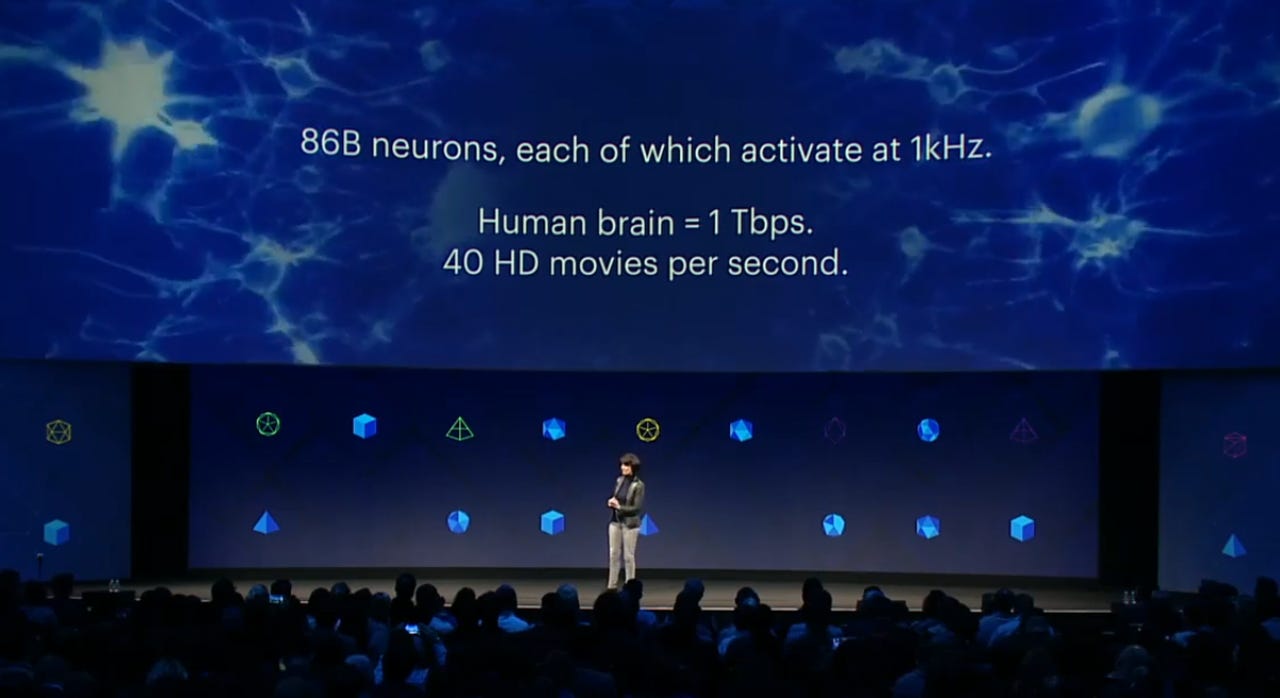F8: Facebook positions itself as an innovator across several fronts

On the second day of its F8 developer conference, Facebook positioned itself as an innovator across all fronts, including software and hardware, to content creation and connectivity. The company introduced new ways it plans to bring AI capabilities to smartphones, new cameras it's rolling out, as well as breakthroughs it's achieved in internet delivery.
The company also shared its grander ambitions of one day enabling people to bypass phones all together and communicate directly with their brain.
Facebook's second day of F8 was squarely focused on innovation. The first day of Facebook's developer powwow was focused on commercial opportunities. To wit:
- Facebook rolls out new integrations, tools for Workplace
- Can Facebook make Messenger the 'yellow pages' of messaging?
- Western Union debuts Messenger money transfer bot at F8
- Facebook unveils new AR, VR platforms and products
- MasterCard sees Facebook Messenger as commerce, bot vehicle for Masterpass
With those commercial deals out of the way, Facebook went with the moonshots. Regina Dugan, head of Facebook's Building 8 research lab, closed Wednesday's keynote address by unveiling the "silent speech interfaces" Facebook is working on. She began her remarks by lamenting the way smartphones keep people from interacting with other people in the same room.
"We know, intuitively and from experience, that we'd all be better off if we looked up a little more often," she said. Voice interfaces, for that reason, have attracted a great deal of attention as the next major user interface. However, Dugan said, "We've only begun to scratch the surface of what's possible."
TechRepublic: Facebook Workplace could replace Slack, Jira, Hangouts, and a lot more | 4 new features for Facebook Workplace that could make it a better business tool
With a team of more than 60 scientists and engineers, "We have a goal of crafting a system capable of typing 100 words per minute, five-times faster than you can type on your smartphone, straight from your brain," she said.
Facebook is also research ways to enable people to "hear through your skin."
"One day not so far away it maybe possible for me to think in Mandarin and you to feel it instantly in Spanish," Dugan said. That sort of capability would have the most benefit, she continued, for the 780 million people around the world who cannot read or write "but can surely think or feel."
Those capabilities are clearly a ways off. Before we can all ditch our smartphones, Facebook intends to bring new, AI-powered capabilities to them.
For instance, the company is bringing its depth-estimation algorithms to smartphones, allowing a single smartphone camera to approximate depth in a single, flat image. This would bring advanced features to any phone, in any mode, explained Joaquin Quiñonero Candela, director of Applied Machine Learning at Facebook. Facebook, he said, is also working on algorithms to apply casual 3D capture to smartphones. To advance all of this research, Facebook has open-sourced the deep learning framework Caffe2.
While it's still working on advancing smartphone cameras, Facebook is already planning to roll out more sophisticated versions of the Surround 360 family of cameras. The x24 and x6 are named to indicate the number of cameras they have.
CTO Mike Schroepfer said the new devices start to solve the "six degrees of freedom problem" with 360-degree cameras.
"For years we've been trying to build videos that made us feel like we were there," he explained. Yet with a 360-degree image or video, "The world is still locked... wherever that camera happened to be placed."
The new cameras were designed in partnership with external company FLIR, incorporating their camera system integration into Facebook's x24 architecture, maximizing pixel overlap in every part of the sphere. "It allows us to take our expertise in computer vision and go to town," Schroepfer said.
Thanks to factors like the quality of depth resolution and the computer vision code on the backend, a viewer can look at an image from the cameras and see positions in a scene that the camera was never there to see.
Facebook's innovations also extend to connectivity. Yael Maguire ran through new breakthroughs in the company's efforts to extend internet connectivity across the globe. Fiber is too expensive and takes too long to reach areas in need of connectivity, so Facebook is trying to innovate "building blocks" of connectivity, Maguire said.
Adding to the several projects already under way, Maguire announced Tether-tenna, a single cable tethered to a small helicopter that can bring fiber to areas in need of quick connectivity, such as places hit by crisis. "For months at a time, it's going to provide connectivity for people who most need it," Maguire said.
The company has set new records in wireless data transfer, achieving 36Gbps over 13km point-to-point using millimeter-wave (MMW) technology. Using Facebook's optical cross-link technology, it's achieved 80Gbps per second between those same points. From a location on the ground to a circling Cessna aircraft over 7km away, Facebook achieved 16Gbps from using MMW.
After piloting its Terragraph system in San Jose, Calif., Maguire announced the system is capable of delivering fiber-like performance, making it the first city-scale mesh millimeter-wave system to do so.
Facebook made its own AI-powered assistant for Messenger
